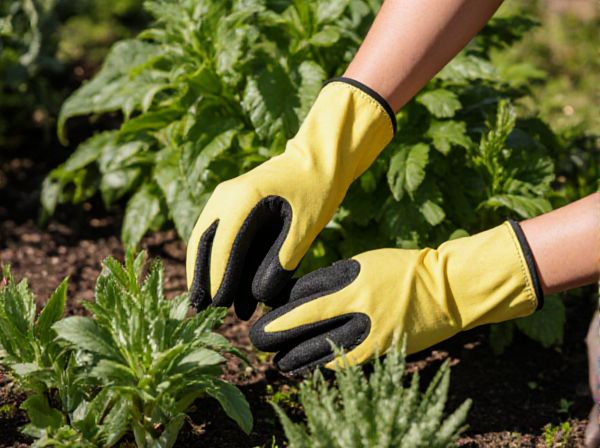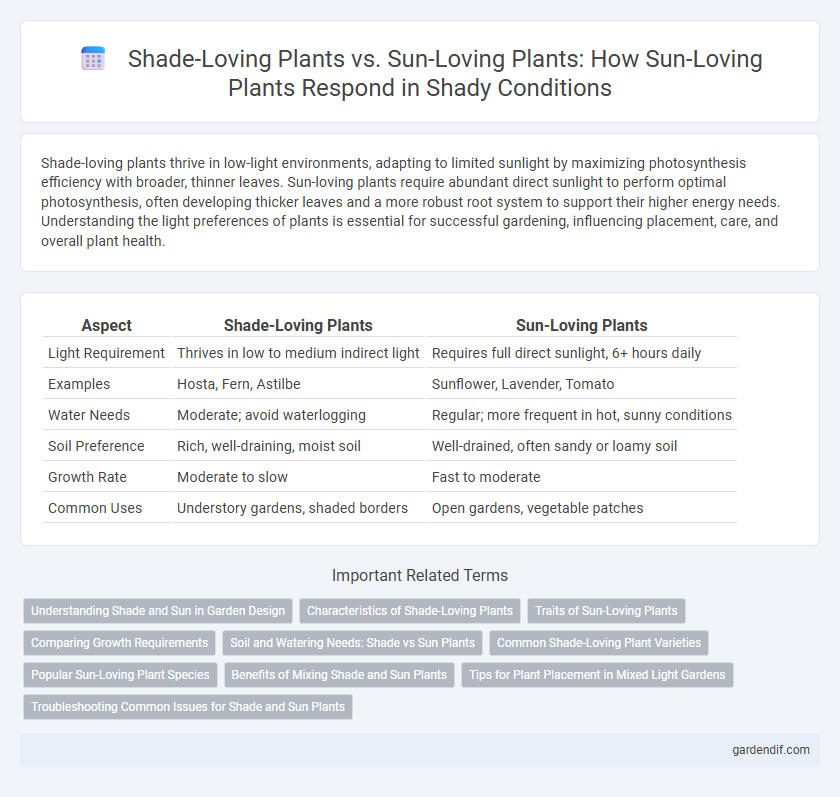
Shade-loving Plants vs Sun-loving Plants Illustration
Shade-loving plants thrive in low-light environments, adapting to limited sunlight by maximizing photosynthesis efficiency with broader, thinner leaves. Sun-loving plants require abundant direct sunlight to perform optimal photosynthesis, often developing thicker leaves and a more robust root system to support their higher energy needs. Understanding the light preferences of plants is essential for successful gardening, influencing placement, care, and overall plant health.
Table of Comparison
| Aspect | Shade-Loving Plants | Sun-Loving Plants |
|---|---|---|
| Light Requirement | Thrives in low to medium indirect light | Requires full direct sunlight, 6+ hours daily |
| Examples | Hosta, Fern, Astilbe | Sunflower, Lavender, Tomato |
| Water Needs | Moderate; avoid waterlogging | Regular; more frequent in hot, sunny conditions |
| Soil Preference | Rich, well-draining, moist soil | Well-drained, often sandy or loamy soil |
| Growth Rate | Moderate to slow | Fast to moderate |
| Common Uses | Understory gardens, shaded borders | Open gardens, vegetable patches |
Understanding Shade and Sun in Garden Design
Shade-loving plants thrive in low-light environments by adapting to limited sunlight through larger leaves and slower growth rates, making them ideal for shaded garden areas beneath trees or walls. Sun-loving plants require full sunlight to perform photosynthesis efficiently, producing vibrant flowers and robust foliage, and are best placed in open, sun-exposed garden beds. Understanding the distinct light requirements of shade and sun-loving plants is essential for garden design, ensuring optimal growth conditions and maximizing aesthetic appeal.
Characteristics of Shade-Loving Plants
Shade-loving plants typically exhibit larger, thinner leaves with higher chlorophyll content to maximize light absorption in low-light environments. These plants often have slower growth rates and adapt by developing broader leaf surfaces to capture diffused sunlight efficiently. Unlike sun-loving plants, shade-tolerant species generally prefer moist, cooler conditions and display less tolerance for direct, intense sunlight.
Traits of Sun-Loving Plants
Sun-loving plants thrive in direct sunlight, exhibiting traits such as thicker, waxy leaves that reduce water loss and enable efficient photosynthesis under intense light. These plants typically have deeper root systems to access water from lower soil levels and often display vibrant flowers to attract pollinators in bright open environments. Adaptations like heat tolerance and the ability to close stomata during peak sunlight hours help sun-loving plants conserve moisture and survive in exposed conditions.
Comparing Growth Requirements
Shade-loving plants thrive in low-light conditions, requiring less direct sunlight and typically developing larger, broader leaves to maximize photosynthesis in dim environments. Sun-loving plants demand high levels of direct sunlight for optimal growth, often possessing smaller, thicker leaves adapted to reduce water loss under intense light. These contrasting growth requirements influence soil moisture preferences, with shade plants favoring consistently moist, nutrient-rich soils, while sun-loving plants tolerate drier, well-drained substrates.
Soil and Watering Needs: Shade vs Sun Plants
Shade-loving plants typically thrive in moist, well-drained soils rich in organic matter, requiring consistent watering to maintain soil moisture without waterlogging. Sun-loving plants prefer soils that drain quickly and can tolerate drier conditions, often needing less frequent watering once established due to their adaptation to higher evaporation rates. Understanding these differing soil and watering needs is essential for ensuring optimal growth and health in shade versus sun garden environments.
Common Shade-Loving Plant Varieties
Common shade-loving plant varieties include hostas, ferns, and impatiens, all thriving in low-light conditions unsuitable for sun-loving plants like lavender or sunflowers. These shade-tolerant plants adapt to environments with limited sunlight by developing larger leaves for maximal photosynthesis. Gardeners often select these species to create vibrant, lush landscapes in shaded areas where sun-loving plants would struggle to survive.
Popular Sun-Loving Plant Species
Popular sun-loving plant species like roses, sunflowers, and lavender thrive in full sunlight, displaying vibrant blooms and vigorous growth due to their high photosynthetic activity. These plants typically require at least six hours of direct sunlight daily to maximize chlorophyll production and nutrient synthesis. In contrast to shade-loving plants, which adapt to low-light environments by developing larger leaves and slower growth rates, sun-loving species excel in bright, sunny conditions and often struggle in shaded areas.
Benefits of Mixing Shade and Sun Plants
Combining shade-loving plants such as ferns and hostas with sun-loving varieties like lavender and marigolds creates a diverse garden ecosystem that maximizes space and improves soil health. This mixture enhances pest control by attracting a wider range of beneficial insects and supports extended blooming periods through varied light requirements. Integrating both plant types increases garden resilience against weather fluctuations and promotes year-round visual interest.
Tips for Plant Placement in Mixed Light Gardens
Shade-loving plants such as hostas, ferns, and astilbes thrive in low-light areas, while sun-loving plants like lavender, roses, and coneflowers require full sun exposure to flourish. When planning mixed light gardens, position sun-loving plants in the brightest, most open areas to maximize photosynthesis, and place shade-loving varieties under tree canopies or near structures that provide dappled or indirect light. Careful zoning based on each plant's light requirements ensures healthy growth, vibrant blooms, and balanced garden aesthetics.
Troubleshooting Common Issues for Shade and Sun Plants
Shade-loving plants often struggle with leggy growth and chlorosis due to insufficient light, while sun-loving plants may suffer from leaf scorch and wilting caused by excessive heat and UV exposure. Correcting these issues involves adjusting the plant's location to match its light requirements, ensuring proper watering schedules, and using nutrient-rich soil to support healthy growth. Monitoring environmental stressors and applying appropriate mulching techniques can also help mitigate common problems for both shade and sun-loving plants.
Shade-loving Plants vs Sun-loving Plants Infographic

 gardendif.com
gardendif.com